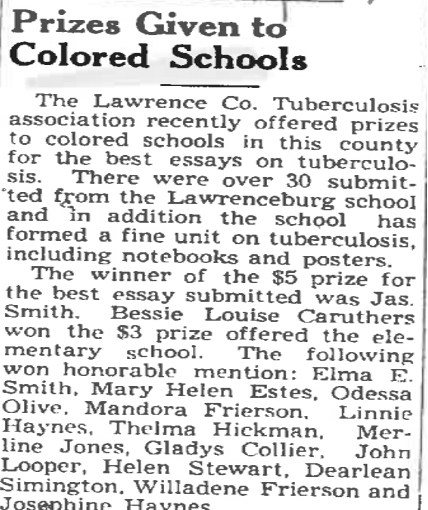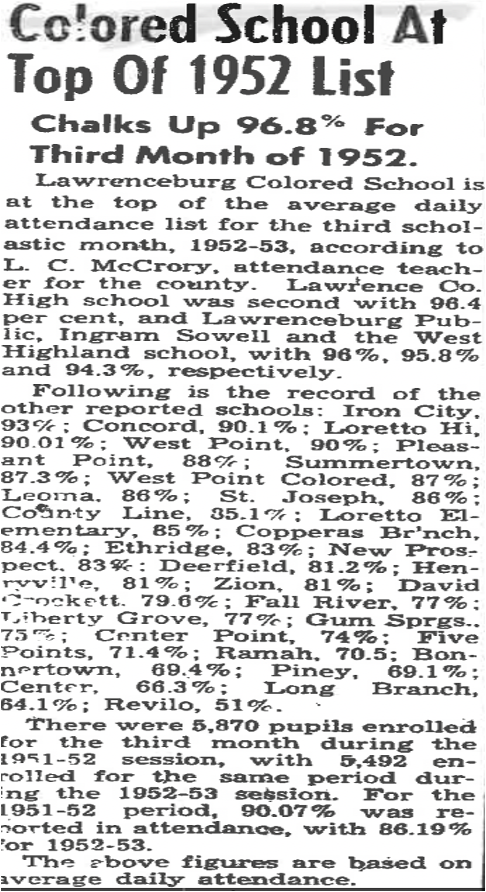In 2019, the West Gaines Community Center was formed to deter the demolition of the formally known West Gaines Colored School in Lawrenceburg, TN, USA. Headed by committee president James Wallace, former alumni have garnered support for the school’s preservation. The school remains significant to the community because it was the only school black children could attend during Jim Crow. More importantly, the black community in Lawrenceburg considers it the last public landmark of their past.
The African American history of education in Lawrenceburg and its county seat Lawrence County remains to be written. We know from Tennessee state records that 5 schools for Black children existed in 1875 and that number grew into the double digits within a segregated school system by the 20th century. The Black population in Lawrenceburg has never been large–about 2 percent in 1900 and most of that participating as tenant farmers in the local agricultural labor force. Not uncommon in the post-Reconstruction South, both Black adults and children participated in the labor force because families needed the income.
In Lawrenceburg, the black population was so small that they were relegated to the west of town, along West Gaines Street and Deller Street. The oldest landmark was St. John’s Methodist Church on West Gaines Street. Behind the church was a two-story frame building that served as Lawrenceburg’s only school for African American students. The school held students from kindergarten to 8th grade and operated from c. 1875 to the early 1930s.
Overcrowding had been a problem since the end of World War I as the county experienced a short-term boom in its agricultural production, especially cotton, and in industrial growth from a shirt factory. Teachers at the Lawrenceburg school during the 1920s were Mattie Caruthers, Lena Rhodes, Jacob Gay, and D.O Burrows. In addition to a school and church as public landmarks, there was a separate cemetery for African Americans, Symington cemetery, north of town.
During the economic boom in Lawrence County, a pivotal leader in the development of Lawrenceburg was James H. Stribling. Stribling was a small-town civic capitalist who invested in institutions that would both best serve his business interests and help the town grow. Founder of the First National Bank in Lawrenceburg, he became a community leader for public education. In 1928, the Lawrence County Board of Education appointed a committee to investigate building a new school for African Americans. The committee consisted of J.H Stribling, Joe Sims, and a Mr. Benson. The committee agreed that there was a need for a new school. By 1929, the committee had selected teachers, received funds from the Rosenwald fund ($500) and Black citizens raised $200 on their own. Also, in 1929, there were discussions of where the school should be located. Land owned by J.H Stribling, west of town, was considered as a potential destination. Stribling’s property was a 3-acre lot in District 8 of Lawrenceburg, and it was adjoined to the James T. Dunn Estate.
The tentative plans were for a 3-room brick building and for it to be supported by funding from the Julius Rosenwald Foundation. By spring of 1931, the committee had decided to proceed with construction of the building, and begin to make decisions on the faculty. The White community, now in the midst of the depression, did not support the location of the Black School on West Gaines Street (also the route of U.S. Highway 64). On April 14, 1931, a coalition of white citizens led by H.D Derrick filed an injunction to keep the school from being built. Derrick argued that the building would depreciate the property values, and disrupt the peace of the white neighborhoods. In the injunction, Derrick stated,
Said bill was filed for a common purpose and was antagonistic to the erection and construction of a negro school building upon said three acre tract assigning reason therefor that it was depreciative of property values in this immediate section and against the peace , tranquility and general welfare of Parties Complainant and repugnant to all white inhabitants and property owners within the immediate section, and further alleging that it was an encouragement to the upbuilding of a negro settlement in the immediate environs of said proposed negro school building.
The White citizens also felt that a West Gaines Street location of the Black school would infringe on their white-only neighborhood and they did not want a new Black school located on the town’s major east-west highway. H.D Derrick and his supporters took their case to the Tennessee Supreme Court but received an unfavorable decision in 1932. Although the citizens lost in the Supreme Court, this legal struggle contributed to the loss of Rosenwald funding first secured in 1929 since the Foundation ended the rural school building program in 1932.
From 1932 to 1937, the Lawrence County Board of Education developed plans for three new schools, one being a new West Gaines site. By the fall of 1937, with funding from New Deal agencies, the new school had been built at the intersection of West Gaines Street and Buffalo Road. Reflecting a general Rosenwald school design, the new building was heated with 65 single desks, 6 tables and 40 chairs.
In 1938, Joe A. Thomas and Willie Mae Parker were announced as principal and assistant principal of the new building. The Junior High School was located inside the same building as the elementary school. Thomas was a well-respected educator, elected by his peers as First Vice President of the Tennessee Negro Education Association in 1939. By the following year, he was president of the association. In 1941, he spoke at the commencement of the McNairy County Rosenwald School. By 1943, Thomas was the principal of the segregated black School for the Blind in Nashville.

For students who exceeded the 8th grade, they were forced travel via bus to Mt. Pleasant in Maury County, the only high school Black students were allowed to attend in the area. Black community members recall the inconvenience segregated schooling provided them. Shirley Dennis recalls black children having to be dropped off at the West Gaines location and then be transported to Mt. Pleasant, more than 20 miles away.

In c. 1950, the county board of education took state funding to add a gymnasium and additional classrooms to the school’s north end. It remained a 1-8 grade school; high school students continued to attend the Mt. Pleasant school in Maury County.

For almost 30 years, the West Gaines school served as the only school for black children in Lawrenceburg. Desegregation of Lawrence County schools led to the closing of West Gaines School in 1964. Black children who were attending the school in its final year were transferred to various schools in the county.
Our Mission
The mission of the West Gaines School Community Center is to preserve the integrity of a piece of Black History, to provide mutually supportive and positive learning opportunities, exhibitions, programs, and events based on collections and research that explores the rich history of Lawrence County, and the culture with their African origins.
We will strive to preserve the history with outstanding collections and research used to produce innovative exhibits that demonstrate significant events and accomplishments of African Americans.

